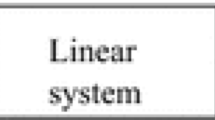Abstract
It is proposed to use an estimate of the scene depth function, the knowledge of which allows restoration of an undistorted scene image, in the framework of the distorted image formation model specified by the Koshmieder equation. The method for estimating the scene depth is based on the registration of a scene image by three identical cameras with a sufficiently large depth of field. Thus, the foreground, middle-ground, and background of the scene appear sharp and clear. The cameras are coaxially arranged at the vertices of a right-angled isosceles triangle, the plane of which is perpendicular to the shooting direction. A reconstruction method based on three observed images distorted by a heterogeneous environment is proposed. It is assumed that the distorted images bring information about an initial image, environment interference function, and sensor noise. The method for suppression of the interference explicitly solves the linear system of equations obtained from a quadratic objective function. The experimental reconstruction results obtained by the proposed method are presented and discussed.





Similar content being viewed by others
REFERENCES
M. Banham and A. Katsaggelos, “Digital image restoration,” IEEE Signal Proces. Mag. 14 (2), 24–41 (1997).
V. Kober and V. Karnaukhov, “Restoration of multispectral images degraded by non-uniform camera motion,” J. Commun. Technol. Electron. 60, 1366–1371 (2015).
V. Kober, “Robust and efficient algorithm of image enhancement,” IEEE Trans. Consum. Electron. 52, 655–659 (2006).
E. M. Ramos-Michel and V. Kober, “Design of correlation filters for recognition of linearly distorted objects in linearly degraded scenes,” J. Opt. Soc. Am. A 24, 3403–417 (2007).
E. M. Ramos-Michel and V. Kober, “Adaptive composite filters for pattern recognition in linearly degraded and noisy scenes,” Opt. Eng. 47, 047204 (2008).
L. B. Lucy, “An iterative technique for the rectification of observed distributions,” Astron. J. 79, 745–754 (1974).
J. Biemond, R. L. Lagendijk, and R. M. Mersereau, “Iterative Methods for Image Deblurring,” Proc. IEEE 78, 856–883 (1990).
R. Fergus, B. Singh, A. Hertzmann, S. T. Roweis, and W. T. Freeman, “Removing Camera Shake from a Single Photograph,” ACM Trans. Graphics 25, 787 ̶794 (2006).
A. Makovetskii, S. Voronin, V. Kober, and A. Voronin, “Tube-based taut string algorithms for total variation regularization,” Mathematics 8 (1141), 20 (2020).
V. Kober, A. Makovetskii, S. Voronin, and V. Karnaukhov, “A fast algorithm of regularization of the total variation for the class of radially symmetrical functions,” J. Commun. Technol. Electron. 64, 1500–1507 (2019).
S. Martinez-Diaz and V. Kober, “Nonlinear synthetic discriminant function filters for illumination-invariant pattern recognition,” Opt. Eng. 47, 067201 (2008).
V. H. Diaz-Ramirez and V. Kober, “Target recognition under nonuniform illumination conditions,” Appl. Opt. 48, 1408–1418 (2009).
V. Kober and V. Karnaukhov, “Adaptive correction of nonuniform illumination of multispectral digital images,” J. Commun. Technol. Electron. 61, 1419–1425 (2016).
H. Horvath, “On the Applicability of the Koschmieder Visibility Formula,” Atmos. Environ. 5, 177–184 (1967).
W. Wang and X. Yuan, “Recent advances in image dehazing,” IEEE/CAA J. Automatica Sinica 4, 410–436 (2017).
K. He, J. Sun, and X. Tang, “Single image haze removal using dark channel prior,” IEEE Trans. Pattern Analysis Machine Intel. 33, 2341–2353 (2011).
J. A. Valderrama, V. H. Diaz-Ramirez, V. Kober, and E. Hernandez, “Real-time image dehazing using local adaptive neighborhoods and dark-channel-prior,” Proc. SPIE Opt. Engineering Appl. 9598, 95981 (2015).
V. Kober, M. Mozerov, and J. Alvarez-Borrego, “Nonlinear filters with spatially-connected neighborhoods,” Opt. Eng. 40, 971–983 (2001).
T. Bishop and P. Favaro, “The light field camera: extended depth of field, aliasing, and superresolution,” IEEE Trans. Pattern Analysis and Machine Intel. 34, 972–986 (2012).
V. V. Sobolev, Transfer of Radiant Energy in the Atmospheres of Stars and Planets (GITTL, Moscow, 1956).
V. Kober, V. P. Vavilov, and V. M. Saptsin, “New method of digital modulative adaptive autocalibration of IR-imaging devices,” in Proc. Eurotherm Seminar, No. 27 QIRT-92, Chatenay-Malabry, Franes, July 7–9, 1992 (EETI, Paris, 1992), pp. 3–7.
J. L. Lopez-Martinez and V. Kober, “Blind adaptive method for image restoration using microscanning,” IEICE Trans. Inf. Systems E95-D, 280–284 (2012).
J. L. Lopez-Martinez, V. Kober, and V. Karnaukhov, “Image restoration with a microscanning imaging system,” J. Comm. Tech. Electron. 59, 1451–1464 (2014).
ACKNOWLEDGMENTS
The work was supported by the Russian Foundation for Basic Research (grant no. 20-47-740007).
Author information
Authors and Affiliations
Corresponding authors
Additional information
Translated by E. Bondareva
Rights and permissions
About this article
Cite this article
Kober, V.I., Saptsin, V.M., Karnaukhov, V.N. et al. Suppression of Heterogeneous Environment Interference Using Multiple Cameras. J. Commun. Technol. Electron. 66, 1470–1475 (2021). https://doi.org/10.1134/S1064226921120111
Received:
Revised:
Accepted:
Published:
Issue Date:
DOI: https://doi.org/10.1134/S1064226921120111




